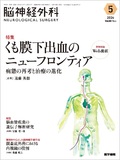Japanese
English
- 有料閲覧
- Abstract 文献概要
- 1ページ目 Look Inside
- 参考文献 Reference
Point
・破裂椎骨動脈解離に対する血管内治療には,母血管である椎骨動脈温存の有無によってdeconstructive治療とreconstructive治療とがあり,病変部の解剖学的条件や特徴を考慮していずれかを選択する.
・それぞれの治療法にメリットとデメリットがあり,確実な止血効果と穿通枝障害はトレードオフの関係にあることを理解することが重要である.
・急性期ステント留置は未だoff-labelの治療法である.抗血栓薬マネジメントなど未解決の問題点を孕んでいることに留意し,十分な説明と倫理委員会における承認など,適切なプロセスを踏んで使用すべきである.
Ruptured vertebral artery dissecting aneurysms(VADA)carry a poor prognosis owing to the high rates of rebleeding, stroke, and mortality without appropriate treatment. Various endovascular techniques are employed to treat these aneurysms. Deconstructive techniques, involving internal trapping with coils, often achieve complete angiographic occlusion at higher rates; however, they carry a risk of medullary infarction. Reconstructive techniques using neck-bridge stents preserve the parent vessel and reduce perioperative morbidity. Nevertheless, these techniques are associated with a higher rate of aneurysmal rebleeding or recurrence. Optimal treatment modalities should be chosen based on the anatomical characteristics of the aneurysm and the trade-off between risks and benefits.

Copyright © 2024, Igaku-Shoin Ltd. All rights reserved.


